Tuesday, 24 July 2007
Distance 26 km
Duration 4 hours 50 minutes
Ascent 341 m, descent 323 m
Map 47 of the TOP 100 blue series (now superseded)
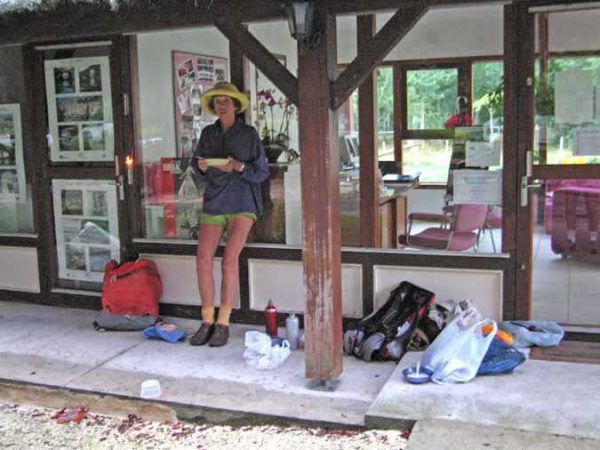
It was still raining slightly when when woke up, so we quickly dismantled our poor bedraggled tent, shook the water off it, then moved everything over to the sheltered step outside the office and ate our muesli there.
By the time we had packed up, it was 7 am and the barrier at the entrance was just being raised, not that it would have stopped a walker. It has also stopped raining.
We turned left onto the road, which, despite being the main route to the north, was pleasant to walk on because of the generous verge and the thinness of the traffic at that hour.
Beautiful orderly fields spread out on either side and powerlines marched to the horizon. The main crops were wheat and corn, interspersed here and there with wide carpets of flowers. We thought they were probably part of the wonderful Jachère Fleurie project, the planting of fallow land with flowers, which has taken such a hold in France.
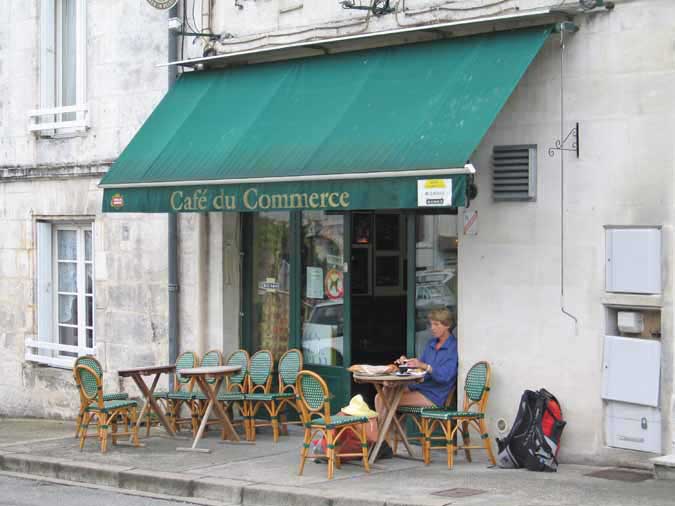
After an hour we passed the stony village of Bertric-Burée with its grey tower, crouched above the road as if in ambush.
Another hour got us to Verteillac, which we were very pleased to reach, as it had everything we required in the form of a fine old Café du Commerce at the corner of the square. It also had a château, a church, a restaurant, several shops and even a camping ground.
In the square that we looked onto as we drank our morning coffee and munched pastries, there was the obligatory war memorial with its long, tragic list of lads from the area killed in World War I, and its much shorter list from World War II.
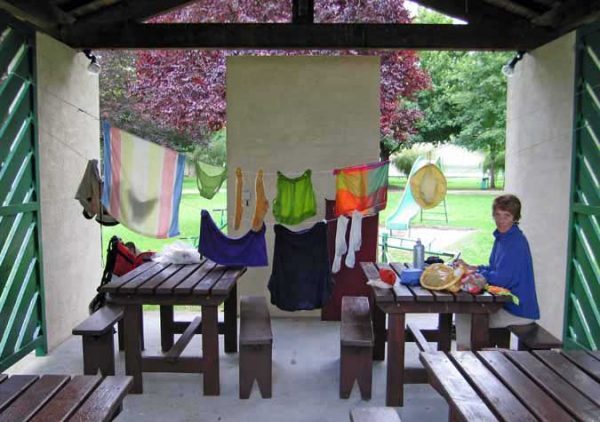
Beyond Verteillac the road continued on its unbending way and the traffic started to annoy us, but as soon as we had crossed the stream known as la Pude Rau, we branched off to the right, losing all the trucks and most of the cars straight away. The land became hillier and more heavily forested, and we passed a sombre château in the woods.
Soon enough we emerged into the top streets of Mareuil, just as the noonday bells were ringing. Down in the square the weekly market was being dismantled and we sat at a bar with our second coffees, enjoying the sight of other people exerting themselves.
We saw a sign, “Camping 300m”, unpleasantly reminiscent of the one in le Rozier, which had stated “Camping 300m à droite” and had turned out to be 4 kilometres away. In the present case the distance was more like 200 metres, along a patched lane beside the stream (this stream was la Belle Rau, to distinguish it from its more modest predecessor).
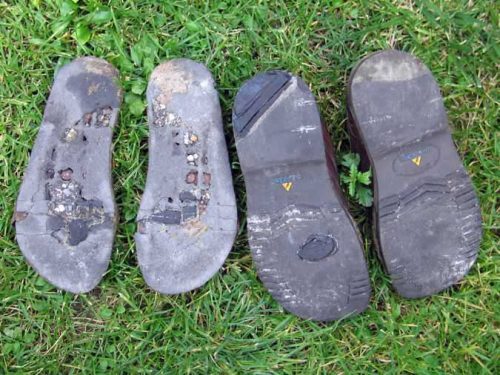
Nobody was at the reception but there were several caravans with Dutch and English registration parked around a circular driveway, with a picnic shelter in the middle. While we were having lunch in this shelter, a sudden rainstorm swept in and we had to move to another table, but we were pleased with ourselves for having arrived before the rain did.
The showers were magnificent and I managed to use up all the hot water by doing my washing while I stood there. We hung our wet things inside the shelter until the sun came out, then moved them to a nearby hedge.
One of our English neighbours told us that there had been floods in England, which made the indifferent French summer seem relatively benign.
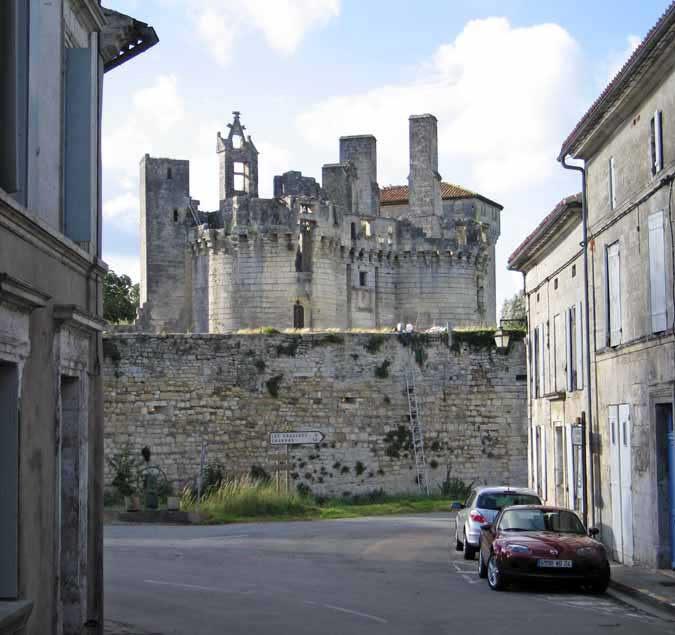
For the last time I repaired my beloved walking shoes, one of the soles having worn right down to the insole. I constructed a patch from some rubbery sheeting that I had found beside the road, and stuck it on with Résist-à-Tout. We only had one more day of serious walking ahead of us.
When the office opened we discovered that the woman in charge was English, which possibly explained the presence of so many English and Dutch campers. She was one of those confident, proprietorial expats who must drive the locals mad, but she did give us useful information about the eateries of the village.
Going back into town later, we noticed that the little river had been diverted along a stone race towards a mill, where the water dropped with a thunderous roar under the building. No power seemed to be generated these days, but the mill house was lived in, presumably by people who found the roar soothing.
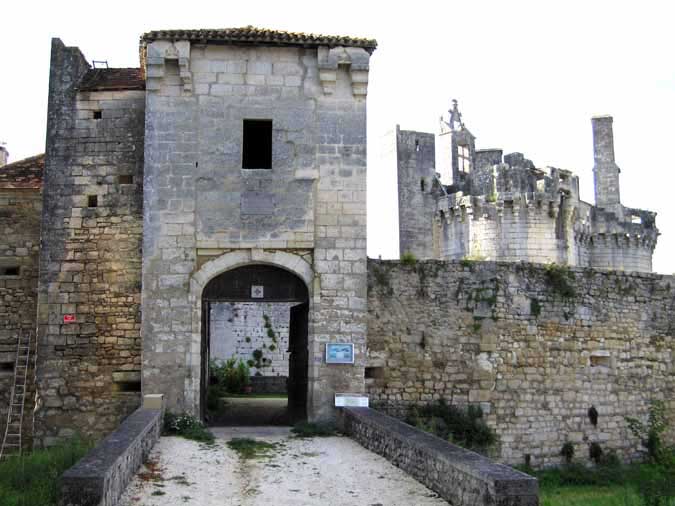
We did a quick tour of the village, which was more extensive than we had supposed, with several other squares. At the far side we came to the château, a particularly atmospheric ruin with the remains of a moat, a great stone portal and a jagged mass of towers behind.
It was very close to the highway which bypasses the town, but we had not noticed it when we drove past in a bus in 2005
Of the three restaurants we had been told about, one was closed on Tuesdays and another was run by English people, so we decided on the third, an upstairs room looking out onto the market square.
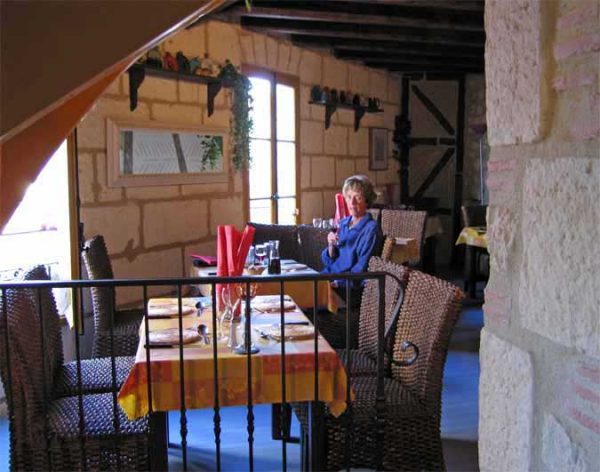
We had a preliminary glass at the bar where we had had coffee when we arrived. It was too cool and breezy to be outside.
In the elegant dining room of the Olive Noire, there was not a soul in sight except for the manageress, who spoke French with a heavy accent (we guessed Dutch).
The menu that we had seen downstairs turned out to be for midday only, and the evening menu was twice the price, so we made do with pizzas.
Later another group came in, all English, and it then transpired that our hostess was also. We might as well have gone to the second restaurant that we had rejected out of hand. We wondered whether there were any French people left in Mareuil.
Previous section: Lalinde to Ribérac